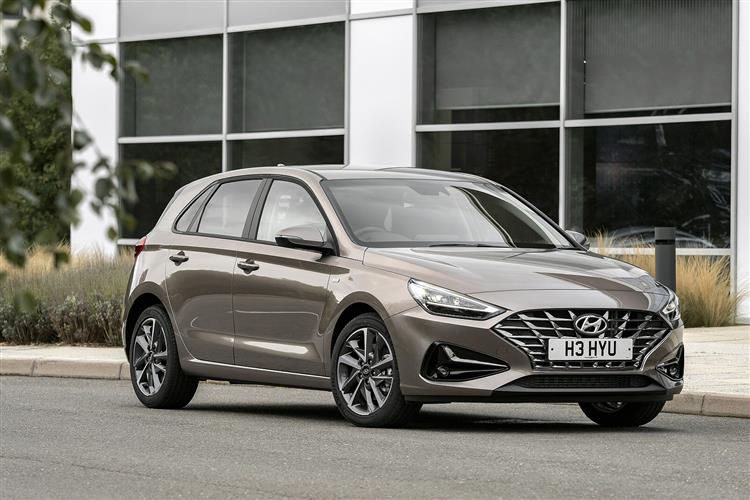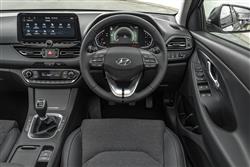THE I'S HAVE IT (some text hidden) --NONE--
By Jonathan Crouch
Hyundai's i30 is a Focus-sized family hatch that's been improving, generation by generation. This improved version of the MK3 model really accelerates its aspirations. Jonathan Crouch reports
Ten Second Reviewword count: 93
If, in choosing a Focus-sized Family Hatchback, you merely want to buy a very good one and pay as little as possible for it, then Hyundai has a proposition for you - its third generation i30, now much improved. The more efficient engines now feature mild hybrid tech, plus there's a smarter look both inside and out and extra safety kit and media connectivity. Overall, it's certainly a more competitive proposition than before. Spacious, sensibly-specced and value-laden, this is one car that all the other big volume manufacturers are keeping their eye on.
Backgroundword count: 144
Cast your mind back to 2007. That was the year the very first Hyundai i30 family hatchback appeared, a Focus-sized model that completely changed the way we thought about Korean cars. Since then, this Asian maker has transformed itself from budget brand to the point where it's now a mainstream quality choice. Can this significantly improved MK3 model i30 help Hyundai progress further in its relentless march to full automotive credibility? It's very firmly a product of evolution rather than revolution. But there's an upgraded engine line-up including a more efficient 1.5-litre T-GDI petrol powerplant. Buyers also get a high-tech dual-clutch 7-speed automatic transmission option. And cutting-edge standards of electronic safety and media connectivity. It all sounds quite promising doesn't it? But then, if this i30 is going to be able to keep pace in this closely-fought segment, it's going to need to be.
Driving Experienceword count: 249
Quite a lot's changed with this revised model on the engine front. The volume 1.0-litre T-GDI 120PS petrol unit can now be ordered with 7-speed auto transmission for the first time. But the key news is that this volume 1.0-litre petrol unit is now available with 48-volt Mild Hybrid technology for better fuel efficiency and for the first time with an eClutch 6-speed iMT Intelligent Manual Transmission (iMT). iMT decouples the engine from the transmission after the driver releases the accelerator. This allows the car to enter into two possible levels of coasting depending on the conditions. With the first level, the engine is idling. With the second level, the engine is additionally temporarily turned off to save even more fuel. For those who prefer to drive automatic, the 48-volt Mild Hybrid option is also available with a 7-speed dual clutch transmission. The 136PS version of the 1.6-litre diesel also gets the 48-volt mild hybrid set-up - and the same two-way transmission choice. There's an all new engine too, a 1.5-litre T-GDI petrol unit with 160PS at the top of the range, which also gets the 48-volt mild hybrid tech. This powerplant is only fitted to the sporty 'N-Line' model. At the top of the range, an improved version of the i30 N hot hatch continues with a 2.0 T-GDI petrol unit developing 280PS. Across the i30 range, Hyundai has improved its SmartSense advanced safety package with 'Lane Following Assist, ' 'Rear Collision-avoidance Assist' and 'Leading vehicle Departure Alert'.
To see the full road test text contact us on 0330 0020 227
Pictures (high res disabled)

.jpg)
|
.jpg)
|
.jpg)
| |||
.jpg)
|
.jpg)
|
.jpg)
| |||

|
Statistics (subset of data only)
Min |
Max |
|
Price: |
£17,400.00 (At 3 Feb 2021) |
£25,210.00 (At 3 Feb 2021) |
Insurance group 1-50: |
8 |
15 |
CO2 (g/km): |
124 |
152 |
Max Speed (mph): |
130 ([1.5 T-GDI petrol]) |
|
0-62 mph (s): |
8.5 ([1.5 T-GDI petrol]) |
|
Combined Mpg: |
48.74 ([1.5 T-GDI petrol]) |
|
Length (mm): |
4340 |
|
Width (mm): |
1795 |
|
Height (mm): |
2650 |
|
Scoring (subset of scores)
Category: Compact Family Cars
| Performance | |
| Handling | |
| Comfort | |
| Space | |
| Styling, Build, Value, Equipment, Depreciation, Handling, Insurance and Total scores are available with our full data feed. | |



